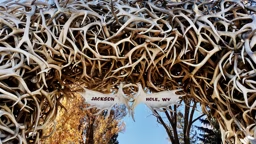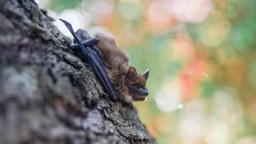The descendents of wolves now sleep by our fireplaces, dive from our docks and walk by our sides agreeably tethered by a leash. The domestic dog has evolved to communicate with us in ways more sophisticated than even our primate relatives are capable of. (Think it’s no big deal that your dog follows your finger when you point? Think again. Not even chimpanzees can pull off this cognitive triumph.) So where did this social intelligence evolve from?
PACK COMMUNICATION
Many of a dog’s most intelligent and refined social skills can be found within a pack of wolves. Their complex interactions maintain the pack structure, and each member contributes to the pack, respecting the dominate-and-subordinate hierarchy that spells success. Wolves are incredibly expressive, and each pack member communicates with its face, ears, tail, posture, voice, and even scent.
Marking territory
Last summer, while driving through northern Wisconsin, I chuckled to myself as I came upon some backwoods humor: A standard, metal street sign officially declared the actual name of the lane. Below it, a handmade green sign read, “Wolf Crap Lane.” I understood the joke well.
A wolf pack will declare the border of its territory with plenty of scat. This odorous and carefully plotted signal describes the pack’s recent activity to any foreign wolf that happens upon it, and the communication may be reinvigorated with a quick “number one” placed deliberately upon the “number two.”
Year-round, wolves mark territorial boundaries with urine. Traveling wolves, much like our dogs on a walk, investigate smells, understand the vivid pictures painted by a nose thousands of times more sensitive than our own, and sometimes reply to the myriad messages with a deliberate line of urine. These raised-leg urinations (or RLUs as they’re known to carnivore biologists) are performed by alpha male and female alike. RLUs declare that a pack is actively working on matters of family and that this freshly marked place is officially territory.
PACK COMMUNICATION
Many of a dog’s most intelligent and refined social skills can be found within a pack of wolves. Their complex interactions maintain the pack structure, and each member contributes to the pack, respecting the dominate-and-subordinate hierarchy that spells success. Wolves are incredibly expressive, and each pack member communicates with its face, ears, tail, posture, voice, and even scent.
Marking territory
Last summer, while driving through northern Wisconsin, I chuckled to myself as I came upon some backwoods humor: A standard, metal street sign officially declared the actual name of the lane. Below it, a handmade green sign read, “Wolf Crap Lane.” I understood the joke well.
A wolf pack will declare the border of its territory with plenty of scat. This odorous and carefully plotted signal describes the pack’s recent activity to any foreign wolf that happens upon it, and the communication may be reinvigorated with a quick “number one” placed deliberately upon the “number two.”
Year-round, wolves mark territorial boundaries with urine. Traveling wolves, much like our dogs on a walk, investigate smells, understand the vivid pictures painted by a nose thousands of times more sensitive than our own, and sometimes reply to the myriad messages with a deliberate line of urine. These raised-leg urinations (or RLUs as they’re known to carnivore biologists) are performed by alpha male and female alike. RLUs declare that a pack is actively working on matters of family and that this freshly marked place is officially territory.
GROWING UP
Pups, born blind and helpless, remain in the den for several weeks before gaining their feet and awakening their senses. They grow quickly on their mother’s milk, and play aggressively with each other, tumbling, rolling, and biting to develop the athletic survival and social skills that will carry them through their adult years.
The den site, so central to the pups’ earliest days, begins to lose relevance as the pups expand their boundaries. As spring moves into summer, the pups’ legs grow long and strong. By late June, the pups are as large as adult coyotes and travel the home range, getting into mischief.
As cohesive as they are with one another, becoming separated from the pack slowly becomes the new reality, and howling for contact becomes an essential life skill. Before they are a year old, just in time for the winter, the pups will have grown enough to help with hunting.
STARTING A NEW PACK
As a wolf ages, it becomes less and less beneficial for it to remain in the midst of the alpha breeding pair. Once a young wolf has attained enough skill and fitness to survive in an uncertain world, it will strike out on its own, whether male or female, leaving family forever.
This lone wolf searches for suitable, unclaimed habitat and a playful mate to begin a new family with. This solo search involves a frightening amount of risk and may go on for hundreds of miles.
For some, it ends with fatal consequences, but for many, the risk is worth the reward, and the role of breeding alpha becomes a reality amid abundant prey, a supportive mate, and good, wild habitat.
Brian Collins studies the wolves of his northwest Wisconsin landscape by track and scat, and, every once in a great while, by observation of this magnificent animal!
Pups, born blind and helpless, remain in the den for several weeks before gaining their feet and awakening their senses. They grow quickly on their mother’s milk, and play aggressively with each other, tumbling, rolling, and biting to develop the athletic survival and social skills that will carry them through their adult years.
The den site, so central to the pups’ earliest days, begins to lose relevance as the pups expand their boundaries. As spring moves into summer, the pups’ legs grow long and strong. By late June, the pups are as large as adult coyotes and travel the home range, getting into mischief.
As cohesive as they are with one another, becoming separated from the pack slowly becomes the new reality, and howling for contact becomes an essential life skill. Before they are a year old, just in time for the winter, the pups will have grown enough to help with hunting.
STARTING A NEW PACK
As a wolf ages, it becomes less and less beneficial for it to remain in the midst of the alpha breeding pair. Once a young wolf has attained enough skill and fitness to survive in an uncertain world, it will strike out on its own, whether male or female, leaving family forever.
This lone wolf searches for suitable, unclaimed habitat and a playful mate to begin a new family with. This solo search involves a frightening amount of risk and may go on for hundreds of miles.
For some, it ends with fatal consequences, but for many, the risk is worth the reward, and the role of breeding alpha becomes a reality amid abundant prey, a supportive mate, and good, wild habitat.
Brian Collins studies the wolves of his northwest Wisconsin landscape by track and scat, and, every once in a great while, by observation of this magnificent animal!
BALANCING THE ECOSYSTEM
For generations, people have framed wolves in a variety of roles, from ecological savior to rogue villain, from spiritual friend to hated fiend. Whatever the view, we are fascinated by them. Wolves play an integral role in their ecosystem by helping to maintain healthy levels of herbivore populations. If an herbivore population gets crowded, it can erode riverbanks, threaten wildflower diversity, and suffer from disease and lack of resources.
However, wolves may present economic strain on livestock operations, occasionally engage in “surplus killing” when prey is easy to take, and sometimes hinder the recovery of some populations of hooved animals. Still, the overwhelming consensus in many places is that wolves belong in the wild landscapes of North America. To see a wild wolf is to see a legendary animal that impacts human emotion perhaps more than any other species. It is, perhaps, one of the richest experiences in the wild.
For generations, people have framed wolves in a variety of roles, from ecological savior to rogue villain, from spiritual friend to hated fiend. Whatever the view, we are fascinated by them. Wolves play an integral role in their ecosystem by helping to maintain healthy levels of herbivore populations. If an herbivore population gets crowded, it can erode riverbanks, threaten wildflower diversity, and suffer from disease and lack of resources.
However, wolves may present economic strain on livestock operations, occasionally engage in “surplus killing” when prey is easy to take, and sometimes hinder the recovery of some populations of hooved animals. Still, the overwhelming consensus in many places is that wolves belong in the wild landscapes of North America. To see a wild wolf is to see a legendary animal that impacts human emotion perhaps more than any other species. It is, perhaps, one of the richest experiences in the wild.
Howling
There are many meanings in wolf howls, though it seems that sometimes they howl for the pure joy of it. Territorial boundaries, while maintained with energy-intensive patrols and scent marking, are most effortlessly defended by howling. Wolf packs howl to tell other wolves, “We live here, and we are strong and healthy. Respect us.” Wolves understand this language well; a bad conflict can be lethal.
To rev up before a hunt, wolves often engage in a vigorous group howling session that grows in intensity and stirs the pack into action. When successful in the hunt or when lost, a wolf will howl to say to the pack, “I’m here. Where are you?” When reunited, the pack’s howls seem to be a joyous way to reconnect and bond.
Pups give lone howls as well, and they learn to swoon and make rich notes of their growing voices by the middle of summer. Hitting those notes is important, because the howl must resonate and carry well through the expansive territory.
HUNTING TOGETHER
The cooperative nature of wolves allows them to pursue large prey, such as moose, elk, bison, musk oxen, and caribou. In my neck of the woods, wolves rely on the ubiquitous white-tailed deer during much of the year. In early spring, they break the culinary monotony by dining on beavers.
Briefly in early summer, white-tailed-deer fawns become the prized catch. While summer pursuits may be more solitary, hunting big game is a cooperative venture.
SOCIAL HIERARCHY
The average wolf pack consists of a breeding male and female – famously termed “alpha” – their pups, and surviving yearling wolves. Occasionally, another adult hangs around – an uncle, aunt or aged sibling who may be hoping to replace one of the breeding adults over time.
There are many meanings in wolf howls, though it seems that sometimes they howl for the pure joy of it. Territorial boundaries, while maintained with energy-intensive patrols and scent marking, are most effortlessly defended by howling. Wolf packs howl to tell other wolves, “We live here, and we are strong and healthy. Respect us.” Wolves understand this language well; a bad conflict can be lethal.
To rev up before a hunt, wolves often engage in a vigorous group howling session that grows in intensity and stirs the pack into action. When successful in the hunt or when lost, a wolf will howl to say to the pack, “I’m here. Where are you?” When reunited, the pack’s howls seem to be a joyous way to reconnect and bond.
Pups give lone howls as well, and they learn to swoon and make rich notes of their growing voices by the middle of summer. Hitting those notes is important, because the howl must resonate and carry well through the expansive territory.
HUNTING TOGETHER
The cooperative nature of wolves allows them to pursue large prey, such as moose, elk, bison, musk oxen, and caribou. In my neck of the woods, wolves rely on the ubiquitous white-tailed deer during much of the year. In early spring, they break the culinary monotony by dining on beavers.
Briefly in early summer, white-tailed-deer fawns become the prized catch. While summer pursuits may be more solitary, hunting big game is a cooperative venture.
SOCIAL HIERARCHY
The average wolf pack consists of a breeding male and female – famously termed “alpha” – their pups, and surviving yearling wolves. Occasionally, another adult hangs around – an uncle, aunt or aged sibling who may be hoping to replace one of the breeding adults over time.
DEN & RENDEZVOUS
Wolves live throughout the northern hemisphere in a variety of habitats, from Arctic tundra to dense and swampy forests. A breeding female needs abundant water to digest her protein-rich diet and produce milk for her young, so a wolf den needs a reliable water source nearby.
Frequently, the ideal spot is near a beaver dam. Making sure adults aren’t away from the den for extended periods of time keeps pups safe from marauding predators, such as fishers (a large member of the weasel family).
There’s an all-important place within the home range where wolf pups scramble to meet the successful adults and bond over play and food; it’s known as the “rendezvous” site. While the location of the rendezvous may change over the summer, it’s the hub of the pack’s activity. Because the rendezvous is central to the pups’ lives, it’s guarded fiercely against all intruding wolves and other threats.
FEEDING THE PUPS
Wolves nurse for about 8 weeks before weaning, and they start feeding on regurgitated meat around week 4. They rely on regurgitation by pack members for 1½–2 months before eating meat that is carried to the rendezvous site, corresponding closely with the time of weaning.
Wolf home ranges can be larger than 100 square miles, and adults venture far and wide to make a kill. Following a successful hunt, the adults’ bellies become transport tanks. For nearly 2 months, adults travel from the kill site to a place where the young can safely feed. The pups, eager to eat, enthusiastically meet the returning hunters, licking the adult wolves’ faces and triggering an ancient reflex: All adult wolves regurgitate stores of meat for the young. (If you’ve ever wondered why our dogs want to lick our faces so badly, now you know!)
Eventually, the adults begin to carry fresh meat to the pups, a transition that’s soon followed by grown pups attending the site of a kill.
Wolves live throughout the northern hemisphere in a variety of habitats, from Arctic tundra to dense and swampy forests. A breeding female needs abundant water to digest her protein-rich diet and produce milk for her young, so a wolf den needs a reliable water source nearby.
Frequently, the ideal spot is near a beaver dam. Making sure adults aren’t away from the den for extended periods of time keeps pups safe from marauding predators, such as fishers (a large member of the weasel family).
There’s an all-important place within the home range where wolf pups scramble to meet the successful adults and bond over play and food; it’s known as the “rendezvous” site. While the location of the rendezvous may change over the summer, it’s the hub of the pack’s activity. Because the rendezvous is central to the pups’ lives, it’s guarded fiercely against all intruding wolves and other threats.
FEEDING THE PUPS
Wolves nurse for about 8 weeks before weaning, and they start feeding on regurgitated meat around week 4. They rely on regurgitation by pack members for 1½–2 months before eating meat that is carried to the rendezvous site, corresponding closely with the time of weaning.
Wolf home ranges can be larger than 100 square miles, and adults venture far and wide to make a kill. Following a successful hunt, the adults’ bellies become transport tanks. For nearly 2 months, adults travel from the kill site to a place where the young can safely feed. The pups, eager to eat, enthusiastically meet the returning hunters, licking the adult wolves’ faces and triggering an ancient reflex: All adult wolves regurgitate stores of meat for the young. (If you’ve ever wondered why our dogs want to lick our faces so badly, now you know!)
Eventually, the adults begin to carry fresh meat to the pups, a transition that’s soon followed by grown pups attending the site of a kill.














